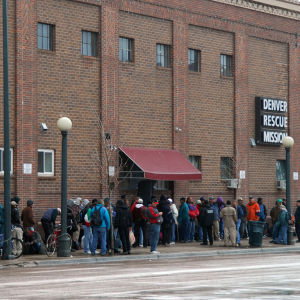Homeless families are among the worst off in the country. The majority are not working, are headed by a single parent, and have exhausted the support of relatives. If we are serious about fighting for Americans being left behind, there is no better place to start than with homeless families.
A new study finds that offering homeless families housing vouchers — with no strings attached and no time limits — does one thing really well; it ends a family’s homelessness. It has associated benefits that come from housing stability like reducing stress, domestic violence and child separations, as well.
But housing vouchers also decrease earnings and increase dependence on welfare programs. Without time limits their cost extends indefinitely. And in any case, they are not a practical solution to a temporary housing problem: Millions of poor families double up and pay large parts of their income in rent. Offering highly valuable vouchers to all families who show up at homeless shelters would almost certainly lead more families to show up at shelters.
In a new report, I point to practical solutions for homeless families that don’t sell them short. They certainly need immediate relief, but they also need real opportunity for empowerment. We already have two solutions that, if retooled, may be capable of just this goal.
The first solution is rapid re-housing. This “light-touch” approach provides temporary rent subsidies to homeless families. Families get back into housing quickly, and they must quickly boost their incomes in order to maintain their housing once the subsidy ends. Nonetheless, some families still end up returning to homeless shelters and most do not achieve self-sufficiency.
Rapid re-housing should be retooled to actively help families make it on their own. This means providing stronger support and incentives for seeking, finding and maintaining work. Heavier involvement of caseworkers should be used when necessary. And families should be allowed to use temporary rental assistance to share housing with family or friends. Shared housing — when safe and stable — can reduce costs and potentially rebuild social support networks.
The second solution is transitional housing. This “heavy-touch” approach is implemented by nonprofit organizations that provide on-site housing and intensive services. New evidence suggests that transitional housing programs may increase earnings and decrease dependence on public assistance, but a large margin of error makes it difficult to draw definitive conclusions. In any case, the quality of programs across the country varies tremendously, so blindly expanding transitional housing is an inefficient strategy.
We need a smarter approach. We must identify and expand transitional housing programs that effectively build self-sufficiency, while cutting public funding for ineffective programs. This requires collecting better data on families who use individual programs so that we can distinguish good programs from bad ones. We can go even further by making program evaluations public so that private donors can fund the highest performers as well.
These solutions for homeless families, however, won’t happen without the right goals. It is easy to fall into the trap of providing Band-Aid fixes that solve housing crises in the short run, without setting families onto a path to self-sufficiency.
We need a new vision. We must provide an efficient housing safety net for families who lose it, but we also need to invest in families to help them make it on their own. Additional funding needed to succeed at these goals should be diverted from federal rental assistance programs that provide indefinite benefits, fail to serve the most needy and tend to diminish self-sufficiency.
Families who experience homelessness are being left behind. We need new solutions that provide an efficient housing safety net along with real means of empowerment. The fight against poverty and inequality of opportunity should start with a fight for the down and out.

